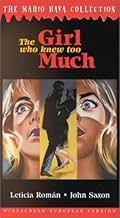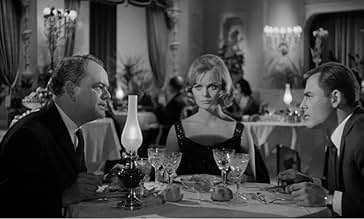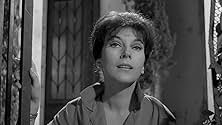ÉVALUATION IMDb
6,9/10
5,8 k
MA NOTE
Ajouter une intrigue dans votre langueA mystery novel-loving American tourist witnesses a murder in Rome, and soon finds herself and her suitor caught up in a series of killings.A mystery novel-loving American tourist witnesses a murder in Rome, and soon finds herself and her suitor caught up in a series of killings.A mystery novel-loving American tourist witnesses a murder in Rome, and soon finds herself and her suitor caught up in a series of killings.
- Prix
- 1 victoire et 1 nomination au total
Letícia Román
- Nora Davis
- (as Leticia Roman)
- …
Walter Williams
- Dr. Alessi
- (as Robert Buchanan)
Giovanni Di Benedetto
- Professor Torrani
- (as Gianni De Benedetto)
Franco Moruzzi
- Policeman
- (as Franco Morici)
Dante DiPaolo
- Andrea Landini
- (as Dante Di Paolo)
Mario Bava
- Uncle Augusto
- (uncredited)
Geoffrey Copleston
- Asylum employee
- (uncredited)
Adriana Facchetti
- Woman in Sguattera Restaurant
- (uncredited)
Histoire
Le saviez-vous
- AnecdotesMario Bava was a big fan of Alfred Hitchcock, and Hitchcockian touches abound in the film, including a cameo by the director. In the scene where Letícia Román is in her bedroom at Ethel's home, the portrait on the wall with the eyes that keep following her is that of Mario Bava.
- GaffesWhen Nora answers the phone in the Torrani house, "hello" is heard before she speaks, even while the receiver is being lifted to her mouth.
- Citations
Nora Davis: [into the phone] Oh mother, murders don't just happen like that here.
- Autres versionsAIP released this as The Evil Eye, a recut version with material used just in some countries out of Italy.
- ConnexionsFeatured in Mario Bava: Maestro of the Macabre (2000)
- Bandes originalesFurore
(Appears in the Italian version)
Sung by Adriano Celentano
Written and Composed by Adriano Celentano (as Adicel) and Paolo Vivarelli (as Vivarelli)
Published by Edizioni Nazionalmusic and Disco Jolly
Commentaire en vedette
- Nora Davis (Leticia Roman) is a young woman hoping to have a wonderful vacation in Italy. Within 24 hours of her arrival, she is almost mistakenly arrested for drug smuggling, the aunt she is staying with dies, she has her purse stolen, and she witnesses a murder. But the police can find no body and no signs of a murder. It seems that no on believes her. It's up to Nora to discover the truth to what happened that rainy night in the plaza.
- Mario Bava is known for his magnificent use of color. So, it's a little odd that two of my favorite films that Bava made (The Girl Who Knew Too Much and Black Sunday) are black & white. Whatever the format, Bava again demonstrates his mastery of shadows and light very effectively. The film presents a series of images that are hard to forget. Each shot is perfection. One of my favorites is of the thief who steals Nora's purse as he moves from one side of the stairs to the other. It is admittedly a very minor moment, but Bava puts more care into this insignificant tracking shot than most director's do in the main scenes of their movies. It is one of the most beautiful films I've ever seen.
- The Girl Who Knew Too Much is an obvious (and not just in title) homage to Alfred Hitchcock. Bava has loaded the movie with moments that are done as I imagine Hitchcock would have done them. If the movie weren't in Italian, you would swear Hitchcock directed it.
- But the thing that make this movie so effective is Leticia Roman as Nora. Her performance is one of the best I've seen in a Bava film. She comes off as fragile, yet determined, depending upon what the script calls for. She has a believability that is necessary for this kind of movie if the audience to feel concern when she is in peril. Roman is perfect in the role.
- One final note, this movie is often cited as the first giallo. Whether this is true or not, I only know what I've read. The Girl Who Knew Too Much does establish a very elementary framework for later gialli to follow. But, it bears little resemblance to the gialli that would come later. It's not until Bava fleshed-out the giallo in Blood and Black Lace do we get look and "rules" that have become so familiar to fans of the genre.
- bensonmum2
- 12 févr. 2005
- Lien permanent
Meilleurs choix
Connectez-vous pour évaluer et surveiller les recommandations personnalisées
- How long is The Evil Eye?Propulsé par Alexa
Détails
- Date de sortie
- Pays d’origine
- Langues
- Aussi connu sous le nom de
- The Girl Who Knew Too Much
- Lieux de tournage
- sociétés de production
- Consultez plus de crédits d'entreprise sur IMDbPro
- Durée1 heure 26 minutes
- Couleur
- Mixage
- Rapport de forme
- 1.66 : 1
Contribuer à cette page
Suggérer une modification ou ajouter du contenu manquant

Lacune principale
By what name was La Fille qui en Savait Trop (1963) officially released in India in English?
Répondre




























